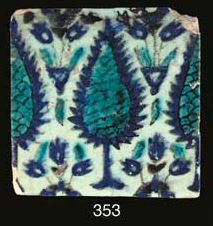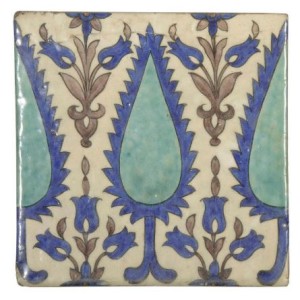I’ve written two posts previously about a mystery tile of mine, one that was similar to an Iznik tile design, but not quite right for a confident identification as such. The first post is here, where I describe the tile, and the second is here, where I went in to a bit more detail about possible Iznik parallels. The skilled ceramists of Iznik in Turkey produced exquisite tiles, tableware and other decorated and glazed objects from the last quarter of the 15th century until the end of the 17th century AD.
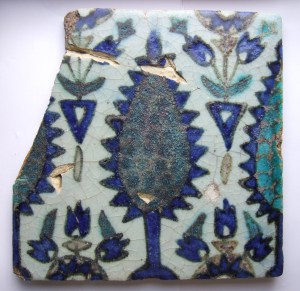
The mystery tile. 22 cm x 22 cm.
The Iznik tiles didn’t quite match my tile, though. The interior of the flower spike in the Iznik examples have a painted fish-scale like decoration motif, whereas my tile had less-defined lumpy blobs with a fuzzier appearance. The background underglaze colours were different too: a crisper whiter colour in the Iznik examples versus the bluey-greyish off white of my tile. So it seemed likely that these were takes on the same design by different ceramic producers. Was one a copy of the other? I would assume mine was a copy of the Iznik tile, as it is less refined and cruder in execution.
After I wrote the second post I contacted Anthony Slayter-Ralph, whose company, Anthony Slayter-Ralph fine art, was selling one of the Iznik tiles I had used to illustrate the post. He very kindly informed me that he thought my tile was Syrian, dating from the 16th or 17th century.
Syrian! That made me wonder—had the local ceramicists seen the beautiful Iznik tiles in the tomb of Muhi al-Din Ibn ‘Arabi (known as Ibn ‘Arabi for short) in the Sheikh Muhiddin Mosque in Damascus, and decided to make their own versions? Ibn ‘Arabi was buried in 1240 AD, but the Iznik tiles were added during a later remodelling of the site.
So armed with this knowledge, I was able to refine my searches a bit. I came up with this page from a Christie’s 2006 auction, with an illustration of four tiles, including one, lot number 353, that looked a dead ringer for mine. Excitement! Closely followed by disappointment when it became apparent that the details for that particular lot were not available on the website for some reason. So close and yet so far!
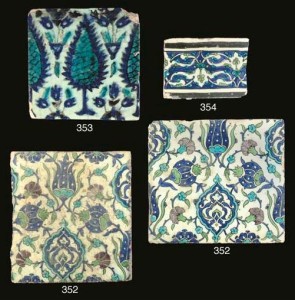
A tile similar to mine (no 353, top left) sold in an auction of Indian and Islamic works of art, Christie’s, London, 7 April 2006.
It’s not a perfect match—again, the ‘pine cone/fish scales’ are painted, unlike on my example, and as there are no details for the Christie’s example—size, country of origin, etc—I am not much nearer knowing. But it’s the best match yet.
In my searches I came across this example too, one of a pair:
which is not such a close match, but it’s the same design, albeit a rather fancier interpretation. This one is attributed to either a Damascus or Jerusalem manufacturer, and dating from later, from the 18th century. It shows how the design retained its popularity.
UPDATE 18 October 2015: A very kind gentleman, Peter Malone, left a comment on my second post about this tile, saying that he thought it was an 18th century Damascus tile, and that the motif was a stylised cypress tree. So that ties in with the general provenance being Syria rather than Turkey. He mentioned a newly-published book which might be of interest: Damascus Tiles: Mamluk and Ottoman Architectural ceramics from Syria by Arthur Millner, published on 1 September 2015 by Prestel, and said that a similar tile was recently offered for sale at Rosebery’s Auction house in London:
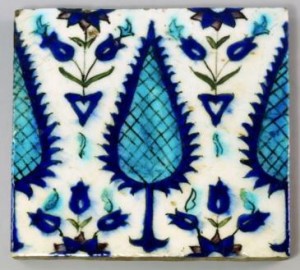
Tile for sale at Rosebery’s Auction house, London, 6 October 2015, described in the catalogue as ‘A Persian tile, 19th century, decorated with stylised foliage and leaves, 23 x 23cm’.
It’s the same design, but again, the treatment of the interior of the cypress tree (as I must now call it) is painted cross-hatching rather than raised bobbles as on mine. It’s also almost the same size as mine. Interesting!
